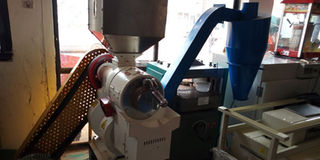Maize huller processes 700 kilogrammes per day

A Maize huller machine is can shell upto 30 bags of 100 kilogrammes per day. Photo by Roland Nasasira
What you need to know:
- Soon after harvesting, many farmers used to employ people to shell maize using their bare hands with the exercise dragging for days and costing more, but with the arrival of hulling machines things are gradually changing, writes Roland D. Nasasira.
Francis Tucungwirwe runs Afri-Taste Limited, an agro processing plant located at Kakiri in Wakiso District, approximately 26 kilometers from Kampala.
At the plant, you will find sacks of maize piled on top of each other awaiting hulling by the N-160 maize huller, a machine he purchased recently to help ease work.
There are also other trucks carrying maize in sacks ready to offload as others are loading the finished hulled maize. “I use the machine to hull maize and it does the work very well and leaves the maize in its fine form and shape. It is also energy efficient and is not susceptible to mechanical breakdown. It is not sophisticated as long as you know how to run it,” Tucungwirwe explains.
Compared to other machines, Tucungwirwe says the N-160 maize huller is much more convenient to farmers that it does not only hull maize but that it can also be used to hull millet when you change the screens.
In a day, he observes that the maize huller can hull between 10 to 15 tonnes of maize and that it can process more than 15 tonnes of millet by virtue of its small grains.
How the machine works
Joan Amooti, the sales assistant at China Huangpai Food Machines at Uganda Manufacturers Association grounds in Lugogo that sells maize hullers says there are three types of maize huller; the N-70, N-120 and N-160.
She says the N-160 maize huller which Tucungwirwe uses can hull or process up to a capacity of 700 kilogrammes per hour.
This can be either removing maize husks to get maize brand as the end product or even obtain broken maize.
Maintenance
In terms of maintaining the machine, Amooti says the company provides aftersales services to the buyer or farmer for a warranty of up to one year from the day it is bought. When a farmer buys the machine, the company carries out the installation process and after a period of one week, they carry out testing and train the operator. In case of any breakdown, the machine readily has spare parts on sale at the dealership and also from other agricultural machine dealers. However, the machine service after the warranty has expired comes at a cost, and so do the spare parts. Amooti Peter Muhumuza, of Katwe Agribusiness Machinery advises cereal farmers to invest in the huller machines. “These machines reduce costs of production in the long run. The machines are so efficient,” says Muhumuza who also runs a maize farm in Pakanyi Sub County, Masindi District.
Advantages
Compared to other N-series of maize hullers, Amooti says the N-160 is of the highest processing capacity because it processes 700 kilogrammes per hour while the other types can process 400 and 500 kilogrammes respectively. It can be installed in a space of approximately (3x4) three against four meters. Its fuels consumption, Amooti says, depends on the timing by the operator because there are those who may leave it running. On average, if it is kept running, it can consumer three to four litres of fuel in an hour. “We have been advising farmers to use maize hullers because they maintain the quality of the seeds,” says Muhumuza.
Advice
Muhumuza warns farmers against shelling maize which is half dry. He says before grinding the maize, he ensures that it is well dried, so that the moisture does not affect the machine. The recommended moisture content is 13.5 per cent. “If maize has plenty of moisture, it sticks on the grinder affecting the sheller and this has to be corrected before use, which costs money,” says Muhumuza, noting he uses two litres of petrol to shell 20 to 30 100kilogramme bags of maize.




